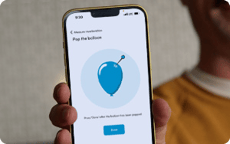21 hybrid learning activities that get students talking

Posted by Tricia Whenham on Feb 24, 2021 6:00:00 AM
Postsecondary hybrid classrooms are on the rise. In these spaces, some students are remote, some attend in person, but everyone needs to be engaged.
This can be incredibly challenging when not everyone is in the same space. All too often, those calling in from home or a dorm room can feel like passive observers. And when it comes to getting all students participating, what used to work well may simply fall flat.
But that doesn’t mean you need to settle for delivering lectures into a void. If you’re looking for some new ways to get your students engaged, here are 21 hybrid learning activities to try.
Before you get started, just make sure you have all the ingredients you need — a UC&C platform that includes breakout rooms, an audio setup with full-room coverage for whole-class work, and adequate bandwidth and tech support. Plus, in-person students will each need a laptop and headphones with an integrated mic for small-group work.
1. Would you rather
With the right questions, Would you rather can go from party game to classroom icebreaker. And once students start talking, that energy can carry over into everything else you do. Just pose a good question and get the conversation going. If you have a large class, it might help to split students up into breakout rooms. (Not sure how? Here’s how it works in Zoom, Microsoft® Teams and Google Meet™ sessions.)
2. Brainteasers
Brainteasers are great for getting ideas flowing. There’s always a trick, and the need to figure it out can wake up even those who are normally disengaged. Here are a few to start with. For an alternative, try asking questions with no firm answer but plenty of opinions. I’ve found the “Is a hot dog a sandwich?” debate to be surprisingly divisive!
3. Remote-friendly improv games
Improv can strike fear in the hearts of introverts everywhere, and it can be even more awkward when people are remote. But low-stakes options (read not embarrassing) are a good activity for hybrid learning. For example, try challenging your students to count to 20 with just one person at a time saying each number. If two people talk at once, you start again. You’ll definitely need good bandwidth for this to work, plus full-room audio coverage so everyone’s voice is picked up. Here’s how Nureva can help.
4. Collaborative concept mapping
When it comes time to activate prior understanding, review for a test or plan a project, shared concept maps get students working together. Divide into small groups and use digital sticky notes to map out ideas. Online whiteboard tools are easy to find — if you use Google or Microsoft, you likely already have access to their software, and there are many free options to try as well.
5. Mystery quotation
This activity lets you see how well your students can apply their understanding of an issue or theoretical position. After you’ve explored a topic, show them a quotation that they haven’t seen before. Their task is to figure out the point of view behind the quotation and explain it. You can do this as a whole-class activity or in small groups (make sure remote students have equal opportunity to take part).

6. Think-pair-repair
This twist on think-pair-share works for remote and in-person students, thanks to the magic of breakout rooms. Start by posing an open-ended question or ask how to solve a problem. But instead of jumping right to a whole-class discussion, place students in pairs, using breakout rooms, and have them discuss until they agree on a response. Then get two pairs together and ask the foursome to do the same thing. If you like, keep recombining until roughly half the class goes head-to-head with the other half to find a resolution everyone can agree on.
7. What’s in a name?
Almost all of us have a story about how we got our name, so try asking students to share theirs. If you pair up remote students with those in person (using breakout rooms), it can help students connect even when they’re not in the same physical space.
8. Collaborative word clouds
Tap into what students are thinking in a highly visual way with word clouds. For example, before introducing a topic, ask the class to add their associations to a shared word cloud. The result is a map of what everyone is thinking, which you can use as a jumping off point for further discussion. (Here’s one free word cloud tool that doesn’t require downloads.)
9. Video reflections
Using video in the classroom takes advantage of a communication style that Gen Z loves — here’s how one instructor at the University of Colorado Boulder does it. You can also have students record themselves as they give a presentation or practice a skill, and then reflect on what they see.
10. What’s in common challenge
What do your students really have in common? It’s a simple question, but it can be fun to see just how far people can go with it. Place pairs or small groups of students in breakout rooms, and ask them to find out what they have in common. They can start in obvious places (age, number of siblings, major, etc.), but encourage them to aim for something obscure and unexpected.
11. Sprint retrospectives
If you need help keeping everyone communicating during extended group projects, try adding sprint retrospectives to the mix. They use simple questions — What did we do well? What do we need to work on? What questions do we still have? — to help groups reflect on their progress and stay on the same page. They’re just one part of agile-based learning.
12. Case studies
Case studies have long been a collaborative way to get students to take a deeper dive into issues, plus show real-world applications of course content. And with UC&C tools, they can work just as well in a hybrid learning class as in a traditional one. To find out how Boston University uses case studies, read this article.
13. 30-second book talks
In this activity, students describe a recent piece of reading — a book or journal article — while someone else times them. The challenge is to come in under 30 seconds while still distilling the essence of what they studied. It’s a quick way for students to share what they’re learning and practice the art of brevity. And it’s simple to expand it to other forms of media (podcasts, films) or even concepts or time periods.
14. Backchannel feedback
When students are listening to a lecture or a classmate’s presentation, have them share their real-time reactions and questions in the chat feature of your UC&C software. This helps remote students stay fully tuned into what’s going on in class, but everyone can use it to spot trends and consider new points of view. Here are a few more ways to use your backchannel.
15. Subject-specific Scattergories
Scattergories, for those who haven’t played it before, is a game where a letter is chosen and then people name something that starts with that letter in a variety of categories — like favorite food or a girl’s name. To give this an academic twist, simply switch the categories to relate to your course topic — e.g., mathematical theorem or classification of organisms. You can get as creative as you like, and then students can work to top each other in the answers they come up with.

16. Classroom debates
Debating is a time-tested way to get students to state positions, formulate arguments and reach conclusions, plus explore an issue from multiple points of view. You can divide the class in two, assigning sides of an issue, with you as the judge. Or have some students take on debating roles while others judge and then switch. Again, it’s crucial your audio picks up everyone’s voice so remote students don’t get left behind. Here’s Toronto Metropolitan University’s guide to debate in the classroom.
17. Academic speed dating
Are students embarking on a big project? Have them cycle through a few breakout rooms where they share their elevator pitches and ask for feedback. As they present their plans during these “speed dates,” they’ll hone their speaking skills, see what isn’t clear and get new perspectives. Here are some other ways Harvard uses academic speed dating.
18. Idea lineup
Choose a question that has a range of responses and gets students to place themselves on a continuum, by adding their name to a simple template in your shared whiteboarding software. Then you can regroup students in a variety of ways to promote discussion — either asking those with similar responses to tease out small differences or asking students with opposite responses to find common ground.
19. Google Docs™ collaborations
Using a shared platform like Google Docs, students can work together to answer a question or share perspectives, all without saying a word. Simple tips like having students color-code their contributions or creating a template to fill out can eliminate confusion and make the process go smoothly. Here are some ideas for document collaboration from a secondary English teacher that would work for a variety of levels and subjects.
20. Icebreaker questions
When all else fails, it’s handy to have icebreaker questions at the ready — either to kick off a class or switch things up midstream if energy is lagging. It’s easy to find questions online — Michigan State has a good list that ranges from silly to thoughtful. Or try this page full of random questions. You just start scrolling and when someone yells stop, it’s time to answer the question your cursor is on (an idea originally shared in Faculty Focus).
21. Quescussion
Think of quescussion as a standard class discussion but only questions are permitted. When someone slips up, everyone yells “Statement!” and the person needs to reword as a question. When done at the beginning of a course, the questions raised let you understand what knowledge your students bring with them. (This is another activity that requires an audio setup with full-room coverage.)
Editor’s note: This post was originally published February 2021 and has been updated.

Posted by
Tricia Whenham
February 24, 2021


















